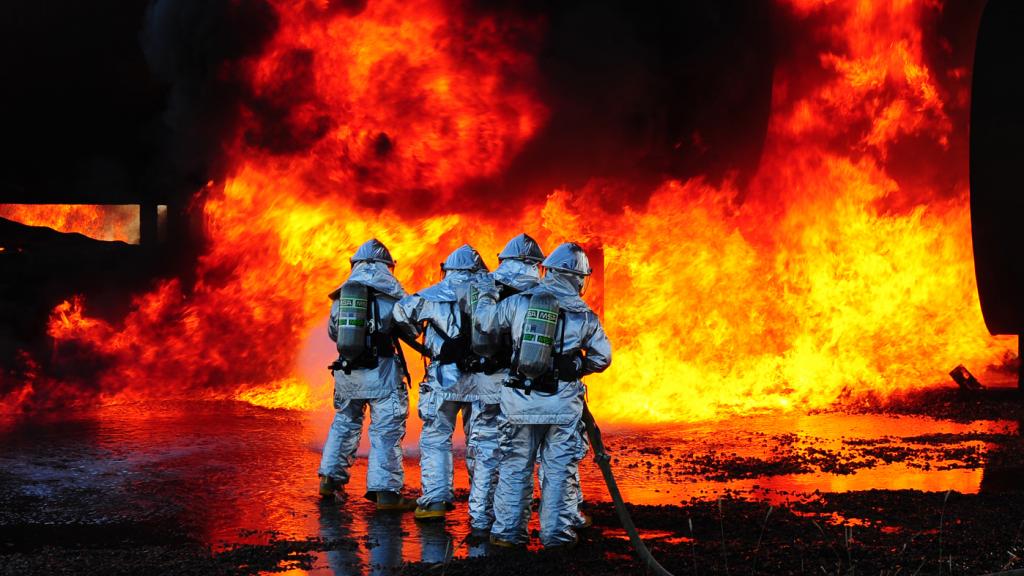Nepal

When Prime Minister Juddha Shumsher Rana visited England around 1936, he was so awe-struck to see fire brigade and fire hydrants in English cities that he decided to introduce them in Nepal too.
A year later, Nepal’s first fire engine, British-made Maurice, was transported to India and then brought to Kathmandu via Bhimphedi, paving the way for the establishment of the country’s first fire brigade, the Juddha Barun Yantra.
It now boasts eight fire engines, out of them three are in “bad shape”. The Juddha fire engines were used to douse a massive fire that gutted a shoe factory – called One World – in Balaju Wednesday afternoon.
The fire, possibly caused by a short circuit, damaged properties worth Rs 45 million, and it took more than three hours for the firemen to put out the fire. So big was the inferno that Nepali Army and Armed Police Force personnel too had to be deployed to the disaster scene.
Wednesday’s factory fire follows a similar inferno in the heart of Kathmandu last month, on July 13, when a busy shopping area in Bhrikuti Mandap was reduced to ashes.
Then, it took four hours for the fire engines from the three cities of the valley – Kathmandu, Bhaktapur and Lalitpur – to control the fire.
Such incidents illustrate a “shocking lack” of preparedness on the part of the federal, provincial and local governments in the capital valley to prevent fire hazards, or deal with them when a big fire breaks out, say experts.
The valley is home to an estimated 5 million people residing in 21 municipalities.
These urban fire incidents are not new to Nepal, according to a recent UNDP report, which ranks Nepal - with crowded and densely populated cities like Kathmandu, Bhaktapur and Lalitpur to name a few - among most vulnerable countries in terms of fire safety.
Experts interviewed by NepalMinute point out three reasons for the fire hazard in Nepali cities.
1. Fire Safety awareness
Safety experts and firemen say a majority of Nepali people are either “careless” or are simply unaware of the risk of fires. It’s happening because of a lack of education about fire safety and precautions one can take at home, shop or office.
They say a few simple steps can go a long way in preventing fire. They include designing and building fire exits in homes and buildings, safe storage and handling of inflammable fuels like LP gas, petrol.
“Unattended cooking is also causing a lot of fires when a piece of cloth burns and spreads the fire causing a huge inferno,” said Chandan Shrestha, chief of Juddha Barun Yantra.
A lot of these hazards are a result of carelessness which can be avoided with a little bit of caution, he adds.
Experts say even businesses seem to be unaware of the fire hazards, including electric short circuits - triggered by use of substandard cables, which are one of the major causes of fire breaking out in buildings and factories.
2. Poor enforcement
For example, the government’s Nepal National Building Code 2015 requires builders to mandatorily install such fire safety equipment as fire sprinklers, smoke detectors and fire extinguishers.
What that means is that all new buildings built after the 2015 earthquake are required to make sure that the buildings can withstand large earthquakes and at the same time prevent fire and inferno by installing fire safety tools and equipment.
For better enforcement of the code, the Code recommends proper monitoring and safety audits. Yet these rules are seldom followed or monitored, said Chandan Shrestha.
He added: “Almost all of the fire incidents are caused due to electric short circuits, and a few are gas and butter-lamp-related.”
3. Lack of preparedness
How ill prepared Kathmandu valley became clear on Wednesday when the limited fire engines struggled to put out the Balaju fire for three hours.
A 2021 research paper,dubbed Urban firefighting in Kathmandu valley by Bhattarai S and his team, published in a journal called Nepjol, concluded that “firefighters are ill-equipped and stressed out”.
The paper also pointed out the traffic chaos of Kathmandu as a “major hindrance” to timely dousing the fire.
Experts say the valley’s fire engines totalling nearly a dozen to serve a huge population are also insufficient.
What about fire hydrants that are designed in the water supply system to refill fire engine’s tanks?
Like fire engines, fire hydrants too were introduced in Kathmandu by Juddha Shumsher 85 years ago.
Chandan Shrestha, the Juddha Barun Yantra chief said: “Fire hydrants work in only a few places, they don’t work in every part of the city. That’s another problem we are facing.”
Plus the city is notorious for its alleyways where fire engines can’t go.
He added: “We have fire bikes too but those have limited capacity. But for 300 to 400 metres we can lay pipes to spray water.”
This shows the lack of preparedness at the governmental level.
Yet Shrestha said Juddha Barun Yantra is second to none in terms of human resource and expertise required to fight fire: “We have many experienced and well-trained persons but that can’t be said for every firefighter elsewhere.”






